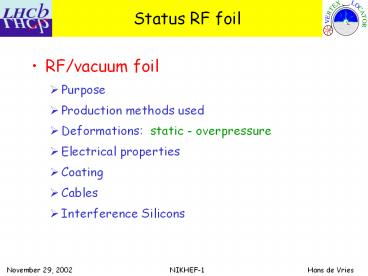Status RF foil PowerPoint PPT Presentation
Title: Status RF foil
1
Status RF foil
- RF/vacuum foil
- Purpose
- Production methods used
- Deformations static - overpressure
- Electrical properties
- Coating
- Cables
- Interference Silicons
2
RF and vacuum separation foil(1)
- Why?
- Separation extreme-high-vacuum of LHC from
Detector vacuum - (outgassing electronics, cables, NEG coating,!)
- Stiffness
- Protect against RF effects
- Wakefields in Vertex vessel
- EMI in detectors
- Good conductivity
- Physics requirement
- Restrict amount of material
- preferably low-Z (small radiation length)
- Thin
- Detectors should overlap
- Alignment
- Stereo angle
- Complicated shape
3
RF and vacuum separation foil(2)
- Production from foil
- Requirements for
- Stiffness
- Welding
- Thickness
- Shape
- Choice of material
- Methods to be used
4
VELO Overview
5
Secondary vacuum box
6
Secondary vacuum box (detail)
7
Material data
Material AlMg3 Young's modulus 70.000
MPa Poisons ratio 0.33 Shear Modulus 27.3
GPa Yield Strength 80-180 MPa Ultimate
Strength 180-260 MPa Electrical
conductivity 1.9x107 ohm-1 m-1 (almost 50 of
pure Al) Weldable!
8
Production of RF foil
- Methods investigated
- Cold formation
- Press- anneal at 420 (or 350 ) - cool- press
- More than 15 cycles, 2 100 bar
- Two or more molds Time consuming
- Explosive formation Uncontrolled
- Superplastic deformation
- Deform at 520
- One cycle, p ? 10 bar Crystal growth, melting,
- Vacuum leaks
- Hot gas forming
- Deform at 350 Formation speed
9
Full size foil
Full size rf foil with reinforcement ribs
10
3D measurement set-up
Exploded view
11
Measurement of one slot
20 x 5 measurement points
12
3D result for one slot
13
Projection for one slot
Variation in depth of one slot 0.1 mm
14
Minimum depth along foil
15
Minima enlarged
Variation in depth for all slots 0.2 mm
16
Close-up minima
Position of slots along foil 0.1 mm
17
Thickness measurements
Along central beam line 0.28 0.29 0.27 mm
0.24 0.27 0.25 0.26 0.30 0.27 0.24 0.27 mm
Largest curvature point 0.15 mm
18
FEM analysis input
Input model for the FEM calculations
19
FEM analysis down
10 mbar over pressure in primary vacuum
Maximum deflection 0.88 mm in floppy part of
foil
20
FEM analysis up
10 mbar over pressure in secundary vacuum
Maximum deflection 1.04 mm in floppy part of
foil
21
Deflection measurement
22
FEA for full box (1)
23
FEA for full box (2)
24
FEA for full box (3)
25
FEA for full box (4)
26
RF pick-up (1)
Foil thickness 30 mm Al Power level in the 50
ohm coaxial line 10 Watts at 40MHz. The Si
detector was 5 mm from the foil outside conductor
of the coax. In this condition there was no
influence on the noise background.
27
RF pick-up (2)
Cut a hole in the foil and put the silicon strip
just 5 mm in front of this hole. The power
level in this coax line was still 10 watt at
40MHz. The fieldlevels from this radiator are
much higher then we can obtain with the beam
through the RF foil. The result was that we do
not see influence on the working of the silicon
in combination with the electronics of the test
setup at NIKHEF in febr. 2002.
28
RF shielding
Frans Kroes has produced a note on Attenuation
of an EM field by AlMg4 screen of 0.2 mm
Conclusion Assuming a conductivity of 0.33 of
pure Al At 1 mm distance to the rf
screen 1.415 x 10-3 V/m
29
Conductivity
- ?Pure Al 37 x 106 Ohm-1 m-1
- Measured (10) conductivity of
- 1 m long 1 cm wide strips of AlMg3
- ?undeformed 17 x 106 Ohm-1 m-1
- ?deformed 11 x 106 Ohm-1 m-1
- 45 for undeformed
- 30 for deformed material
30
Coating
- The extreme deformation might result in tiny
leaks in the material. - Also a protective layer might be used at the
inside of the detector box. - Apply poly-amide-imide coating
- Solution in N-Methyl-2-Pyrrolidone (NMP)
- Drying and polymerization at 60º, 150º, 260º and
315º C - Properties like Kapton and Torlon
- Good electric insulation
- Radiation resistant 30 MGy, strength not changed
- Outgassing properties have been studied
31
Final solution
- A thin layer of poly-amide-imide is air brushed
on the inside of the foil for electrical
protection and to increase vacuum tightness
Effect of the layer Leak detection With
Helium Before After 1.2e-3 3.2e-7 1.2e-5 7.2e-7 3
.6e-5 5.2e-7 3.8e-5 2.4e-6 1.2e-6 3.2e-7
32
Cabling
- Cables inside vacuum
- Heat production
- Signal shielding
- Kapton with 3 Cu layers
- 25 micron kapton outside layer
- --- 17 micron Cu (foil)
- 75 micron kapton
- --- 17 micron lines (100 micron width)
- 75 micron kapton
- ---17 micron Cu (foil)
- 25 micron kapton outside layer
33
Outgassing (1)
Outgassing poly-amide-imide coating
34
Outgassing (2)
Poly-amide-imide coating 1.5 m2 Kapton
cables 20 m2
35
RF foil and Silicons
36
RF foil and Silicons-reinforcements
37
Summary
- Full size RF/vacuum foil has been obtained
- Material 300 mm Al with 3 Mg
- Minimal radius 8 mm
- Deviations measured 0.3 mm
- FEM analysis has been performed
- Variations measured for 10 mbar overpressure
- Electrical properties measured
- Application of poly-amide-imide
- Kapton cables with 3 Cu layers

